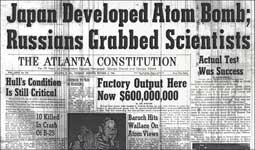I don’t know if this has been discussed here, but…

In a series of articles written by ex-US Army CID investigator turned postwar journalist David Snell, for the Atlanta Constitution, it is claimed that the Japanese conducted a successful nuclear test in Korea shortly before the end of the War in 1945. The articles and claims were quickly forgotten and evidence was difficult to corroborate because the test area was in the Soviet zone in what is today North Korea:
[b]Japan Developed Atom Bomb;
Russia Grabbed Scientists[/b]
Copyright 1946 by the Atlanta Constitution and David Snell.
Actual Test Was Success
Japan developed and successfully tested an atomic bomb three days prior to the end of the war.
She destroyed unfinished atomic bombs, secret papers and her atomic bomb plans only hours before the advance units of the Russian Army moved into Konan, Korea, site of the project.
Japanese scientists who developed the bomb are now in Moscow, prisoners of the Russians. They were tortured by their captors seeking atomic “know-how.”
The Konan area is under rigid Russian control. They permit no American to visit the area. Once, even after the war, an American B-29 Superfortress en route to Konan was shot down by four Russian Yak fighters from nearby Hammung Airfield.
I learned this information from a Japanese officer, who said he was in charge of counter intelligence at the Konan project before the fall of Japan. He gave names, dates, facts and figures on the Japanese atomic project, which I submitted to United States Army Intelligence in Seoul. The War Department is withholding much of the information. To protect the man that told me this story, and at the request of the Army, he is here given a pseudonym, Capt. Tsetusuo Wakabayashi.
The story may throw light on Stalin’s recent statement that America will not long have a monopoly on atomic weapons. Possibly also helps explains the stand taken by Henry A. Wallace. Perhaps also, it will help explain the heretofore unaccountable stalling of the Japanese in accepting our surrender terms as the Allies agreed to allow Hirohito to continue as puppet emperor. And perhaps it will throw light new light on the shooting down by the Russians of our B-29 on Aug. 29, 1945, in the Konan area.
When told this story, I was an agent with the Twenty-Fourth Criminal Investigation Department, operating in Korea. I was able to interview Capt. Wakabayashi, not as an investigator or as a member of the armed forces, but as a newspaperman. He was advised and understood thoroughly, that he was speaking for publication.
He was in Seoul, en route to Japan as a repatriate. The interview took place in a former Shinto temple on a mount overlooking Korea’s capital city. The shrine had been converted into an hotel for transient Japanese en route to their homeland.
Since V-J Day wisps of information have drifted into the hands of U.S. Army Intelligence of the existence of a gigantic and mystery-shrouded industrial project operated during the closing months of the war in a mountain vastness near the Northern Korean coastal city of Konan. It was near here that Japan’s uranium supply was said to exist.
This, the most complete account of activities at Konan to reach American ears, is believed to be the first time Japanese silence has been broken on the subject.
In a cave in a mountain near Konan, men worked against time, in final assembly of genzai bakuden, Japan’s name for the atomic bomb. It was August 10, 1945 (Japanese time), only four days after an atomic bomb flashed in the sky over Hiroshima, and five days before Japan surrendered.
To the north, Russian hordes were spilling into Manchuria.
Shortly after midnight of that day a convey of Japanese trucks moved from the mouth of the cave, past watchful sentries. The trucks wound through valleys, past sleeping farm villages. It was August, and frogs in the mud of terraced rice paddies sang in a still night. In the cool predawn Japanese scientists and engineers loaded genzai bakudan aboard a ship in Konan.
Off the coast near an inlet in the Sea of Japan more frantic preparations were under way. All that day and night ancient ships, junks and fishing vessels moved into the anchorage.
Before dawn on Aug. 12 a robot launch chugged through the ships at anchor and beached itself on the inlet. Its passenger was genzai bakudan. A clock ticked.
The observers were 20 miles away. This waiting was difficult and strange to men who had worked relentlessly so long who knew their job had been completed too late.
…
